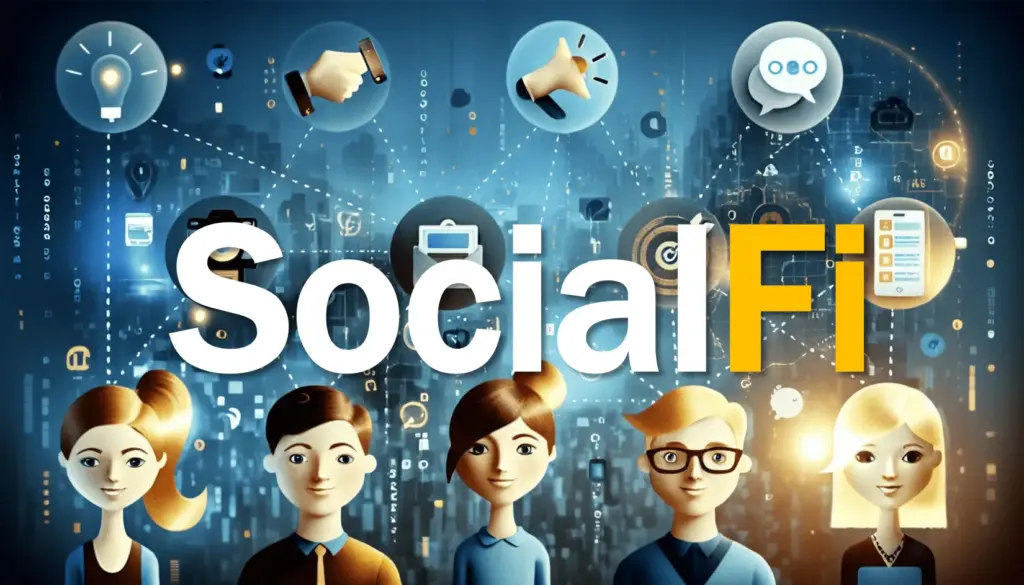Since the latter half of 2024, SocialFi has been generating significant buzz. Now, in 2025, it’s stepping into the mainstream, becoming a hot topic. More than just a superficial “earn-money-on-social-media” concept, SocialFi is emerging as a key driver of the Web 3.0 era, poised to fundamentally reshape online communication and economic activity. While initial skepticism labeled it as a playground for speculative “get-rich-quick” schemes or even a Ponzi, its robust growth, fueled by innovative technology and user-centric value creation mechanisms, has positioned it as a promising new frontier in the digital asset market.
In this post, we’ll delve into the core concepts of SocialFi, its key features, notable projects, the current market landscape, and future prospects. Our aim is to provide you with a clear understanding of SocialFi and offer insights into the emerging opportunities of the Web 3.0 revolution.

What Exactly is SocialFi?
SocialFi is a neologism blending Social Network Service (SNS) and Decentralized Finance (DeFi). It represents a paradigm shift from traditional, centralized SNS platforms that monopolize user data and profits. By leveraging blockchain technology, SocialFi offers users data ownership and opportunities for direct financial rewards. The core idea is that users can earn economic benefits directly through their content, interactions, and influence.
📌 Key Aspects of SocialFi:
- Decentralized Ownership: Users retain ownership of the content and data they create, not the platform. This provides freedom from censorship and unilateral policy changes imposed by platforms.
- Token-Based Economy: Native platform tokens enable users to earn rewards through various activities such as content creation, curation, and community engagement. This mechanism is crucial for driving user participation and platform growth.
- Novel Social Interactions: Beyond simple “likes” and “comments,” SocialFi facilitates new forms of social interaction like token-based tipping, membership purchases, and shared content ownership, fostering closer and more direct relationships between creators and their audience.
The Allure of SocialFi: Why the Growing Interest?
SocialFi’s rapid growth stems from several compelling features that traditional SNS platforms lack:
- Genuine User Rewards: Unlike traditional SNS where platforms monopolize advertising revenue, SocialFi distributes token rewards based on user contributions, incentivizing content creation and community participation. This provides tangible economic benefits and fosters greater platform loyalty.
- Censorship-Resistant Expression: The decentralized nature of blockchain technology allows for relatively censorship-free content publishing and communication. This promotes information diversity and contributes to the formation of healthier online communities.
- Community-Driven Growth: SocialFi platforms thrive on the voluntary participation and contributions of their users. The token economy plays a vital role in fostering a sense of shared success and community ownership.
- New Revenue Streams for Creators: Beyond advertising and sponsorships, creators can generate income through direct fan support, NFT sales, and membership models. This enriches the creator ecosystem and enables sustainable content production.
Key SocialFi Projects to Watch
The market currently features a diverse range of SocialFi projects, each with unique features and visions. Here are some notable ones:
- Friend.tech: This decentralized social network gained significant traction in the latter half of 2023 with its introduction of “Shares.” Users can purchase shares of other users, granting them direct communication access or exclusive content. The price of Shares fluctuates based on supply and demand, creating new avenues for social investment and earning opportunities. (As of April 2025, Friend.tech has surpassed approximately $2 billion in cumulative trading volume, leading the SocialFi market.)
- Farcaster: A decentralized social network protocol providing a foundation for developers to build various social apps. Services like Warpcast and Yup, built on Farcaster, are expanding the decentralized social ecosystem. (Farcaster’s active user base has been steadily growing, exceeding 300,000 monthly active users as of Q1 2025.)
- Lens Protocol: Built on Polygon, this decentralized social graph protocol allows users to own their profiles and content as NFTs, enabling interaction with various decentralized social applications. (Lens Protocol is currently integrated with over 200 diverse applications and is actively used.)
- Deso (Decentralized Social): A decentralized social network built on its own blockchain. Users can earn its native token, $DESO, through activities like content posting, following, and liking. It also offers features like an NFT marketplace and creator funds. (As of April 2025, $DESO has a market capitalization of approximately $500 million.)
SocialFi’s Rapid Growth and the Challenges Ahead
The SocialFi market entered a significant growth phase starting in 2024, expanding considerably by 2025. (Reports from various market research institutions project the SocialFi market size to reach approximately $5 billion by the end of 2025.) Venture capital investment is also active, and major cryptocurrency exchanges are increasing their support for SocialFi-related tokens.
However, alongside this growth, several challenges need to be addressed:
- Improving User Experience (UX/UI): Currently, many SocialFi platforms can feel complex and difficult for mainstream users. Enhancing user experience to make them more accessible and user-friendly for those less familiar with Web 3.0 technology is crucial.
- Regulatory Uncertainty: As SocialFi involves new forms of digital assets and services, the regulatory landscape across different countries remains unclear. Continuous monitoring and preparation for future regulatory changes are necessary.
- Security and Privacy Concerns: While based on blockchain technology, vulnerabilities in smart contracts and user negligence can lead to security incidents. Additionally, careful consideration of personal data protection and management is required.
- Building Sustainable Economic Models: Platforms that offer excessive rewards to early adopters or rely heavily on speculative elements may struggle with long-term sustainability. Establishing healthy and sustainable tokenomic models is paramount.
The Future of SocialFi: A Key Driver of the Web 3.0 Era?
Despite these challenges, SocialFi holds immense potential to become a key driver of the Web 3.0 era. This is because it aligns with Web 3.0’s vision of building a decentralized internet environment centered around value exchange and community.
- Revolutionizing the Creator Economy: SocialFi will pave the way for creators to monetize their content and influence more fairly and transparently. This will foster the production of more diverse and high-quality content, contributing to a healthier creator ecosystem.
- Forming New Types of Online Communities: SocialFi communities, built on shared token value, can foster stronger bonds and encourage voluntary participation and contribution. This can overcome the shortcomings of traditional SNS and cultivate a more constructive and productive online communication culture.
- Integration with Web 3.0 Services: In the future, SocialFi is expected to integrate more closely with various Web 3.0 services such as DeFi, NFTs, and DAOs. This will provide users with richer and more diverse experiences, playing a significant role in driving the growth of the entire Web 3.0 ecosystem.
In Conclusion
As we’ve explored, SocialFi is a rapidly growing and innovative field leveraging decentralized technology to present new possibilities for online communication and economic activity. Projects like Friend.tech, Farcaster, Lens Protocol, and Deso are pioneering the market, offering users new value and experiences.
While challenges such as improving user experience, regulatory uncertainty, security concerns, and building sustainable economic models exist, the potential of SocialFi and the momentum of the Web 3.0 era suggest a high likelihood of overcoming these hurdles and becoming a significant pillar of the future internet ecosystem.
To sum up, SocialFi is more than just “earn-money-on-social-media”; it’s about empowering users with true ownership and rewards, fostering new forms of online communities, and driving the growth of the Web 3.0 ecosystem. It’s crucial to continue observing the changes and developments in the SocialFi market.


